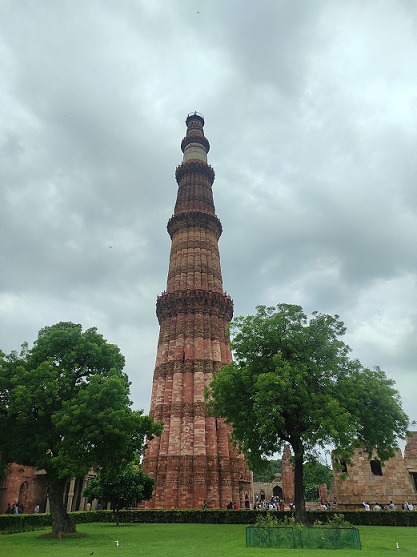Your trip to Delhi is not complete wuthout a visit to the iconic Qutub Minar. It is one of Delhi’s oldest surviving minarets, located in Mehrauli of South Delhi. Since its construction in 1192 by Qutub-Ud-Din Aibak, the first ruler of the Delhi Sultanate, the minaret has withstood several natural disasters and continues to stand tall to this day.
Qutub Minar is the world’s tallest brick minaret, standing 72.5 metres tall. The Qutub Minar in Delhi is part of the larger Qutub Minar Complex, which houses several historic monuments. If you are a history enthusiast or an art and culture buff, this is the place that you must visit.
There are several reasons attributed towards construction of the minar. The most commonly accepted reasons are that, in order to commemorate the advent of Muslim dominance in Delhi (and India), the first ruler of the Delhi sultanate, Qutb-ud-din Aibak, was inspired by the Minaret of Jam in Afghanistan and wished to outdo it, and thus began construction of the Qutb Minar in 1192 A.D. Shamsu’d-Din Iltutmish, his successor, finished the minar.
Let’s delve deeper into the history of Qutub Minar to understand why it’s such an important part of Delhi’s history.
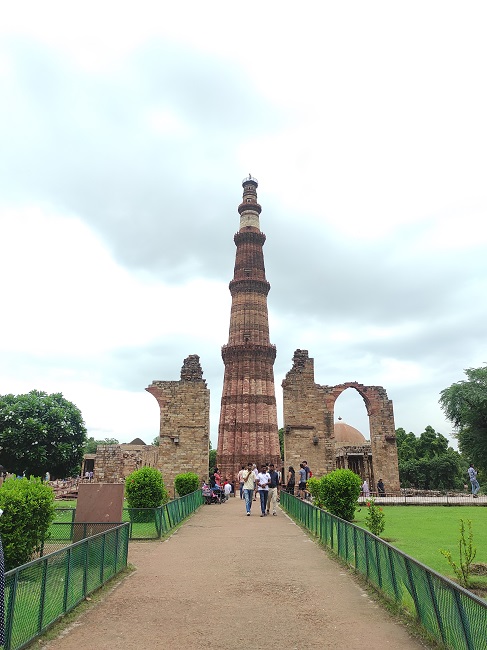
Post Contents
Qutub Minar History
The Qutub Minar in Delhi is a five-story structure built over four centuries by various rulers. It was originally commissioned as a victory tower by Qutb-ud-din Aibak, the founder of the Delhi Sultanate, around 1192. The minaret is named after him, despite the fact that he was only able to complete the first story.It is also possible that the minar is named after Khwaja Qutbuddin Bakhtiar Kaki, a 13th-century sufi saint who was highly venerated by Shamsuddin Iltutmish, successor and son-inlaw of Qutbuddin Aibak, who added three more floors to the structure in 1220. Its topmost story was damaged by lightning in 1369. Firoz Shah Tughlaq rebuilt it, adding the fifth and final story to the tower, while Sher Shah Suri built the entrance to Qutub Minar.
Around 300 years later, in 1803, the tower was severely damaged by an earthquake. Major Robert Smith of the British Indian Army repaired the structure in 1828. He went ahead and built a pillared cupola on top of the fifth story, giving the tower a sixth story. This extra storey, however, was removed in 1848 on the orders of Henry Hardinge, the then-Governor-General of India, and reinstalled next to the minaret. Since 1981, when an accident inside the tower killed 47 people, access to the tower has been restricted.
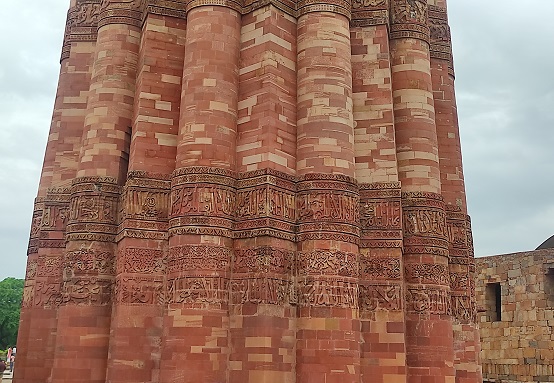
More on Delhi monuments: Visiting the spectacular and peaceful Lotus Temple in Delhi
Qutub Minar Architecture
Qutb Minar stands 72.5 metres (238 feet) tall and was built as a minaret, a tower-like structure commonly found in mosques and used for the Muslim call to prayer. The red sandstone tower is intricately decorated with alternating angular and rounded flutings. The undersides of its balconies are adorned with stalactite bracketing, and the surface of the minaret is engraved with Quranic texts and geometric patterns. The spiral staircase has 379 steps and is located on the fifth floor of the five-story structure.
Each level of the monument is supported by its own balcony and designed brackets.
The marbles or stones used in the monument differ for each level. The first, second, and third floors are made of red sandstone, while the fourth is made of marbles and the fifth is a combination of both red sandstones and marbles.
The base diameter of the tower is 14.3 metres (47 feet), tapering to 2.7 metres (9 feet) at the top. The Quwat Ul Islam Mosque is located at the foot of the tower. The Minar tilts slightly more than 65 cm from vertical, which is considered safe.This tower represents a synthesis of traditional Islamic architecture and Southwestern Asian design.
The minaret, like many mosques built in South Asia during this time period, was built by Hindu labourers and craftsmen but was overseen by Muslim architects. This resulted in a structure that was a blend of Hindu and Islamic religious architecture. As the craftsmen were Hindus who were unfamiliar with the Quran, the inscriptions are a jumbled collection of Quranic texts and other Arabic expressions.
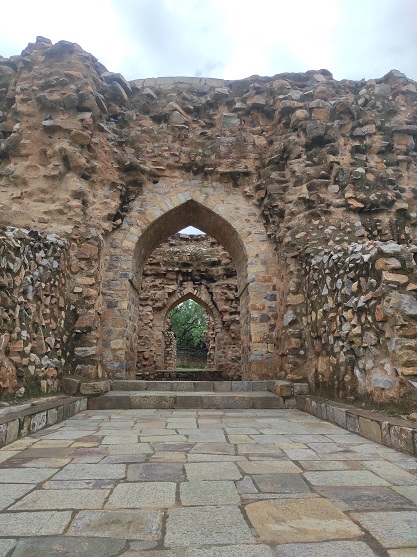
Monuments in Qutub Minar Complex
The Qutub Minar complex brings together layers of cultural, religious, and political history. Its beautiful gateways, tombs, lofty screens, and pillared colonnades bear testimony to a centuries-long history of artistic vision, construction techniques, and patronage. The Qutub complex is centred on a twelfth-century mosque, an early example in the rich history of Indo-Islamic art and architecture.
When you enter the Qutub Minar complex, you can see a collection of structures dominating the landscape of the complex apart from the majestic Qutub Minar that stands tall and magnificent.
Subsequent rulers, including the Tughlaqs, Alauddin Khilji, and the British, added structures to the complex. Aside from the Qutb Minar and the Quwwat ul-Islam Mosque, other notable structures in the complex include the Alai Darwaza , the Alai Minar, and the Iron pillar.
Let’s explore the Qutub complex.
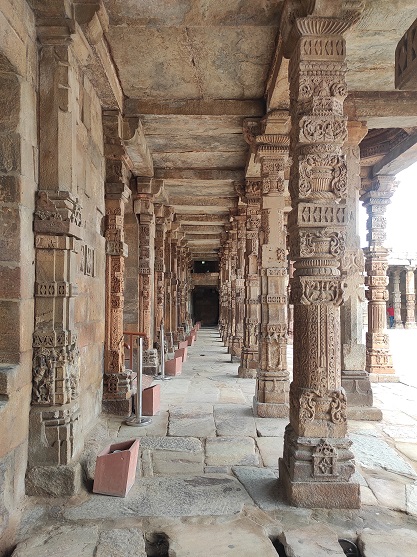
Also Read: Bodh Gaya travel: A self-enlighening journey into the land of Buddha
Quwwat-ul-Islam Mosque
Quwwat-ul-Islam is a unique example of the fusion of Hindu and Islamic art . The mosque’s name literally translates to “Might of Islam.” It is also known as the Qutb Mosque or the Great Mosque of Delhi, and it was the first mosque to be built in Delhi following the Islamic invasion of India. This mosque was built by Qutb-ud-din-Aibak, the founder of the Slave or Mamluk dynasty. Its design and style are similar to that of Ajmer’s Adhai-Din-ka-Jhonpra, which was built after demolishing the Jain temples and the Sanskrit learning centre.
The construction of this mosque began in 1193 A.D. and was completed in 1197 A.D. This mosque appears to be built on the ruins of Jain and Hindu temples. Built by Slave ruler Qutb-ud-din-Aibak after Muhammad Ghori’s accession to Delhi, this historical mosque is supported by twenty-seven pillars, which appear to be taken from Hindu temples built by the Tomars and King Prithviraj Chauhan. This apart, an iron pillar taken from a Vishnu Temple adorns the middle of the mosque’s prayer hall and is known as the “pillar of the law.”
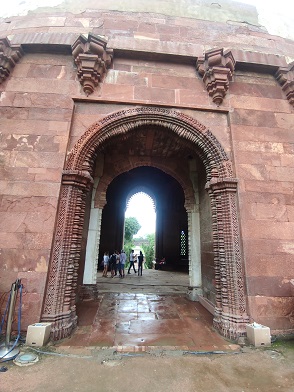
Alai Darwaza
As you enter Qutub Minar Complex you can spot Alai Darwaza to the north of Qutub Minar.
Alauddin Khilji built the Alai Darwaza in 1311 AD, with exquisite inlaid marble decorations and latticed stone panels. The Alai Darwaza was built as part of Aladdin Khilji’s expansion of the Quwwat-ul-Islam mosque. It was one of four grand gateways built by the Sultan; the other three were never completed due to Alaud-din’s death in AD 1316.
This is the main entrance from the mosque’s southern side. It highlights the remarkable skills of Turkish and local artisans who worked on it. It is regarded as one of the most notable structures built during the Delhi Sultanate period. Alai Darwaza follows the traditional Islamic style. It was built with red sandstone and white marble on the exterior walls.
Alai Darwaza is built on symmetrical principles, with a square plan and a large dome on top. It is 17.22 metres long on the outside, 3.3 metres thick on the inside, and 10.6 metres long on the inside. The dome is simple, which contrasts with the ornately carved walls.The northern arch of the Alai Darwaza is semicircular in shape, but the other arches have the traditional horseshoe Islamic design. The entrance gateways are adorned with Quranic inscriptions and floral motifs in white marble and red sandstone.
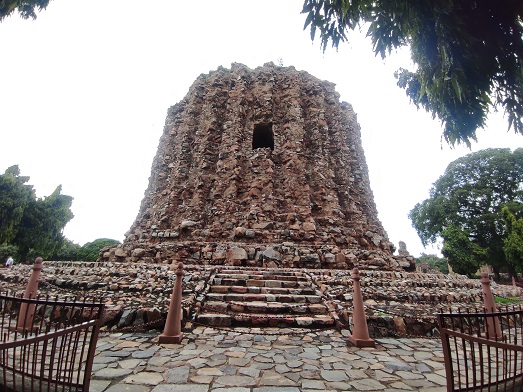
Must Read: Top Things to Do in Hyderabad (2022)
Alai Minar
While exploring the Qutub Complex you come across Alai Minar, an unfinished monument located just north of Qutub Minar.
The Alai Minar is a massive structure that Alauddin Khilji began in 1311 AD. Sultan Alauddin Khilji, an overly ambitious Khilji dynasty Sultan, desired to construct a structure twice the height of Qutub Minar to commemorate his victory over one of his Deccan campaigns. He also carried out the plan, expanding the enclosures of the Quwwat-Ul-Islam mosque by four times its original size in order to provide a ceremonial entrance gateway on either side of the mosque.He wanted the Alai Minar to match the increased height of the mosque and also wanted a second tower of victory in his name, so the Alai Minar was built.
The construction was completed up to the first storey but was abandoned after Sultan Alauddin Khilji’s death in 1316 AD and the subsequent successors were defeated and the Delhi Sultanate was lost to the Tughlaq dynasty.
The total height of Alai Minar is 24.38 metres, with a circumference of 77.72 metres. The outer wall of the tower is 5.8 meters thick and divided into 32 faces of 2.43 meters. The interior is designed with a central column around which the steps to the top are to be built. The diameter of the central column is 8 meters. The passage through which the steps were to be built is 3 metres wide. The entrance is on the tower’s eastern side.
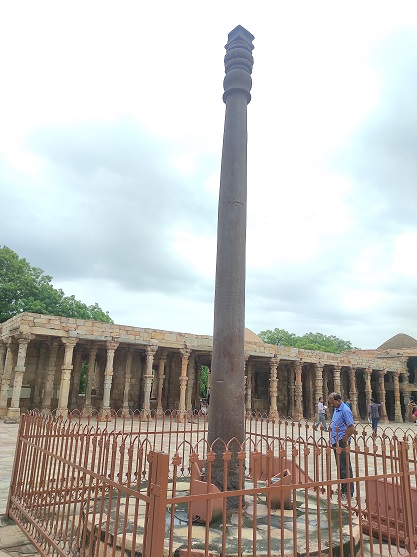
Iron Pillar
Another amazing monument that will allure you is the Iron Pillar located in the Qutub Complex
The Iron Pillar was built around the 4th century to honour Lord Vishnu and to remember Chandragupta II Vikramaditya (375-413). According to inscriptions and archaeological evidence, the Iron Pillar of Delhi was originally located in Udayagiri near Vidisha in Madhya Pradesh. Shamsuddin Iltutmish, during his invasion of Malwa in 1233 AD, brought it to its current location. It was erected as a flag pole, and it is still unknown how this pillar came to be in Qutub Minar. The pillar weighs 6 tons and is made up of 98% wrought iron. The pillar contains Sanskrit inscriptions in Brahmi script.
The pillar has sparked the curiosity of archaeologists and material scientists due to its high corrosion resistance and has been described as a “testimony to the high level of skill achieved by the ancient Indian iron smiths in the extraction and processing of iron.
Do Read; A trip to the Udayagiri caves near Bhopal
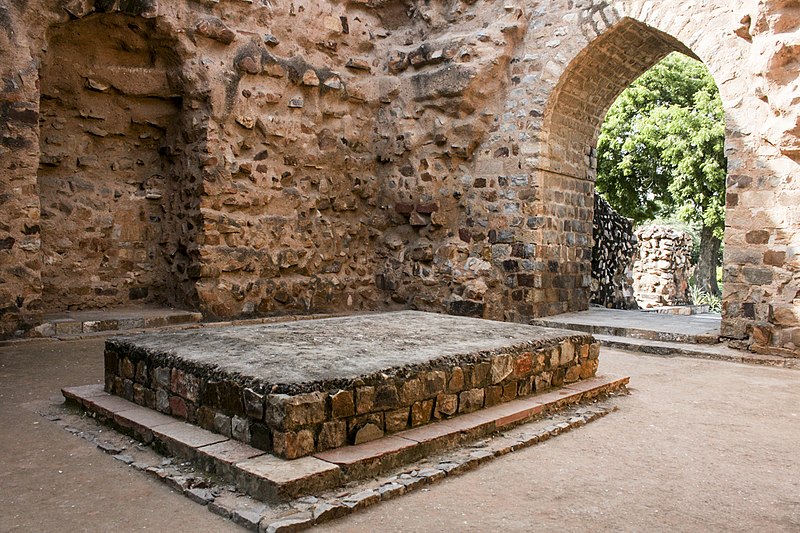
Alauddin Khilji Madarsa and Tomb
The Qutub Complex also houses the Tomb of Alauddin Khilji and the Madrasa. It was the first structure in India to have a tomb alongside a Madrasa.
The Madrasa is located to the south-west of the Quwwat-ul-Islam Mosque. Alauddin Khilji founded it as a centre for study of Islamic scriptures and theology. It has rooms and halls arranged around a quadrangular court. Screened walls were originally present on the eastern and western sides of the quadrangular court. On the western side, there are seven small, cell-like structures that are thought to have housed teachers and staff. The doorway on the north side is intricately carved.
The dome of the central rooms of the madrasa, which houses Alauddin’s tomb, has now been lost, though many rooms remain intact. It is believed that Alauddin’s body was brought to the complex from Siri and buried in front of the mosque, which was part of the madrasa adjacent to the tomb.
The tomb is a simple brick structure with no decorative marble or intricate carvings. There were two small chambers connected to the tomb by passages on either side. The tomb is in terrible shape. Firoz Shah Tughluq repaired the tomb complex.
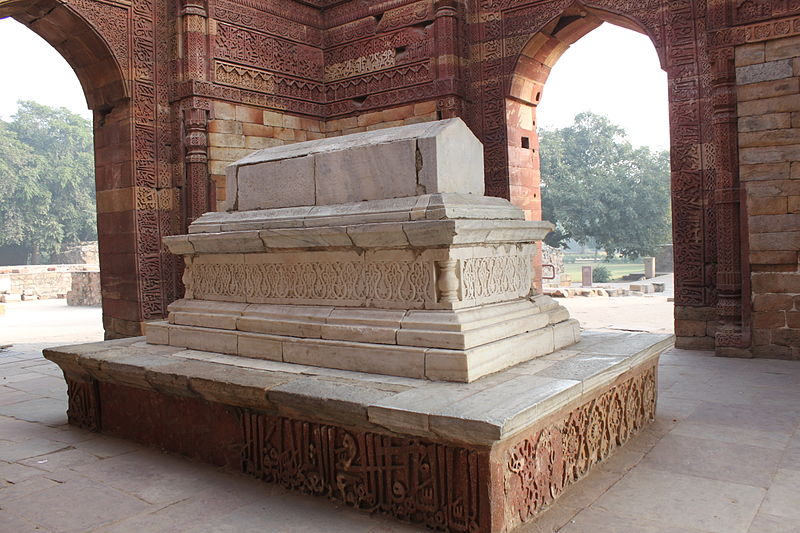
Tomb of Iltutmish
The tomb of Iltutmish, the second Sultan of Delhi (r. 1211-1236 AD), which was built in 1235 CE, is also part of the Qutb Minar Complex. The central chamber is 9 metres square and has squinches, indicating the presence of a dome that has since collapsed. The main cenotaph is made of white marble and stands on a raised platform in the centre of the chamber. The entrance and interior walls of the facade are known for their ornate carving. The interior west wall features a marble prayer niche and a rich amalgamation of Hindu motifs into Islamic architecture, including bell-and-chain, tassel, lotus, and diamond emblem.
The grave chamber was discovered in 1914 during excavations by Archaeological Survey of India’s (ASI) Gordon Sanderson. Twenty steps lead down from the north of the tomb to the actual burial vault.
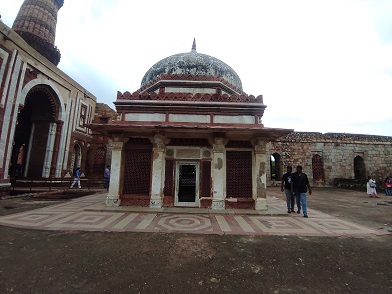
Tomb of Imam Zamin
The Tomb of Imam Zamin is a 16th-century tomb located in the Qutub Minar complex. It houses the tomb of Mohammad Ali (popularly known as Imam Zamin), an Islamic cleric who migrated from Turkestan to India during Sikandar Lodi’s reign. During the reign of Mughal emperor Humayun, Ali himself built the tomb. This tomb has no connection to the rest of the complex’s monuments.
You may like: Chowmahalla Palace of Hyderabad: An ode to the architectural wonder of Nizam legacy
How to reach Qutub Minar
- The nearest airport to Qutub Minar is Indira Gandhi International Airport, which is 13.8 kilometres away and takes 32 minutes to reach by road..
- The nearest railway station to the Qutub Minar is New Delhi Railway Station, which is 17 kilometres away and 55 minutes away.
- The nearest bus stop to Qutub Minar is located just outside the monument’s entry gate. To get to this monument complex, take a DTC bus from anywhere in the Delhi NCR.
- The nearest Metro Station to the monument is Qutub Minar Metro station and residents of Delhi can take the metro to Qutab Minar Metro Station. The monument is 6 minutes drive from the metro exit, so you can hail a taxi.
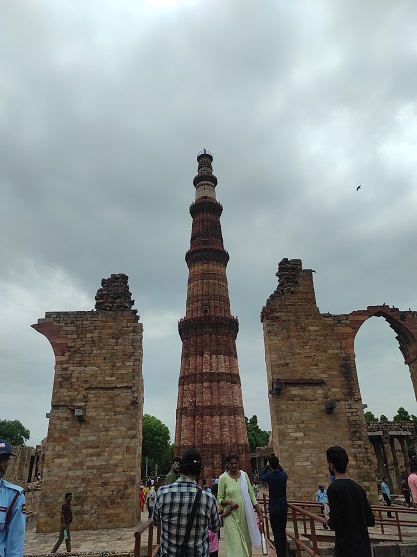
Qutub Minar FAQ
Entry is Rs 40 for Indians and free for children upto the age of 15. For foreigners, the ticket price is 600 INR.
Qutub Minar remains open on all days of the week, and the visiting timings are from 7:00 am to 5:00 pm. The best time to visit this monument is during the winter season, when the weather is cool and pleasant for sightseeing.
With a height of 73 metres, Qutub Minar is one of India’s tallest minarets. It is a UNESCO World Heritage Site and the world’s tallest brick minaret. This 12th-century minaret is thought to be India’s first Islamic structure, with Arabic and Brahmi inscriptions.
The Iron Pillar, a mysterious component of the Qutub Complex, is popular for being built with a unique metal composition that makes it corrosion-resistant.

